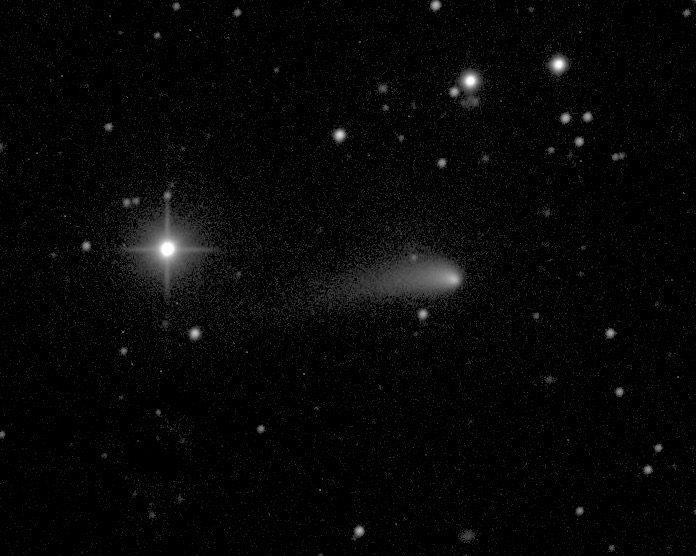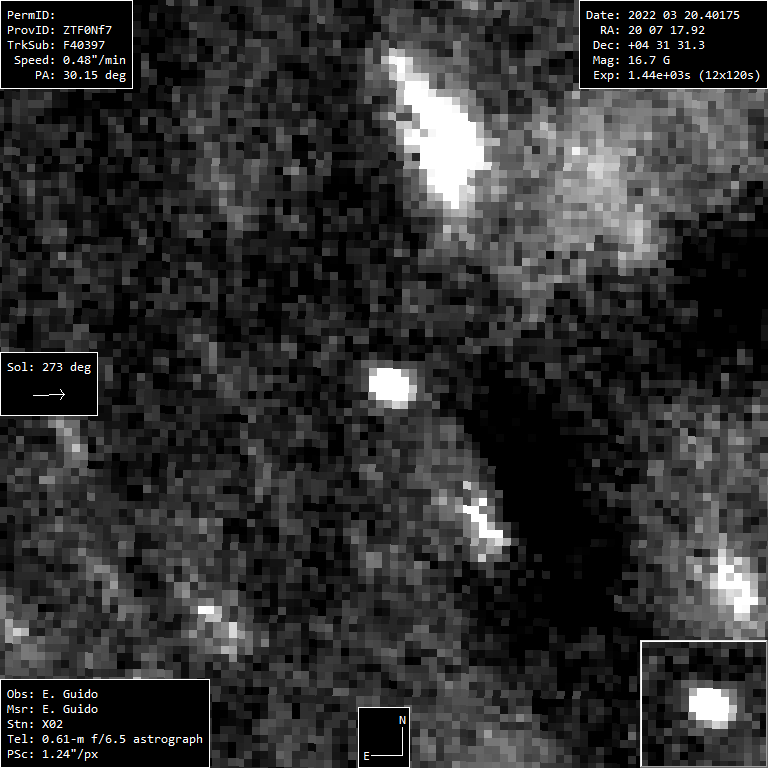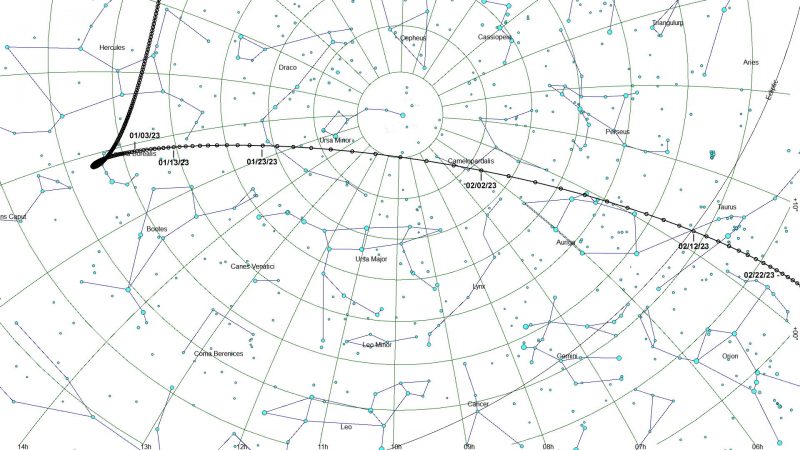
Comet 2022 E3 might be a bright one
On March 2, 2022, astronomers discovered a new comet. It was far from the sun, at a distance of 4 astronomical units (AU, or Earth-sun units of distance). As of September, the comet was still dim and difficult to see without large telescopes. But when it comes nearest the Earth and sun in early 2023, the comet should become easily visible in binoculars.
Astronomers call this comet C/2022 E3 (ZTF). It got its name because it was the third such object discovered in the fifth half-month (A, B, C, D, E) of this year. The ZTF stands for the Zwicky Transient Facility, which uses the 48-inch (1.2-meter) Samuel Oschin robotic telescope, located at Mt. Palomar in southern California.
Closest approach to the sun and Earth
The discoverers announced comet C/2022 E3 (ZTF) in Central Bureau Electronic Circular No. 5111, in which calculated orbital elements appear. The comet will reach its closest point to the sun, its perihelion, on January 13, 2023. At that time, it will be 1.11 AU (1.11 Earth-sun units of distance) from the sun.
The comet will reach its closest point to the Earth, 0.29 AU or 27 million miles (44 million km), on February 2, 2023. It isn’t yet known if this comet has visited the inner solar system in the past. Astronomers must make more observations and calculations to determine that.
The path of comet C/2022 E3
The tilt of the orbit to our path around the sun is steep and retrograde, meaning the comet goes around the sun in the opposite direction than do the planets. This means it will, at some point, move quickly through our sky.
Finally, the comet enters our solar system from the north, and on February 12, passes to the south of our orbital plane. This means Northern Hemisphere observers will have the better view until then, and after that the Southern Hemisphere gets the best view.
Interesting #comet confirmed:
C/2022 E3 (ZTF)
After perihelion on Jan 13, 2023 it approaches earth to 0.29 AU on Feb 2. By then it may be brighter than magnitude 6 while conveniently located for N. hemisphere observers in Camelopardalis.
MPEC 2022-F13 and https://t.co/a7m73XRPFh pic.twitter.com/MDEuGcGxNd— Gideon van Buitenen (@giddgvb) March 21, 2022
The discovery story
Comet C/2022 E3 (ZTF) was in the morning sky, in the direction of the constellation Aquila the Eagle, when astronomers with the Zwicky Transient Facility first spotted it.
The ZTF program images the whole Northern Hemisphere every two nights looking for supernovae, variable stars, binary stars, flashing merging neutron stars, asteroids and comets. It has discovered 10 comets in the past three years, and half of them carry the acronym ZTF in their names. One, discovered a year ago, was named C/2021 E3 (ZTF). Similar name, but don’t confuse the two comets. Today, we are talking about the 2022 one!
At its March 2022 discovery, this comet was a very faint 17th magnitude. Initially, it appeared as a stellar object, that is, as a dimly shining point. But, unlike the stars, whose distances make their motions undetectable except via special techniques, this object was moving in front of the stars.
As of September 2022, the comet shines at magnitude 13.

Confirming its cometary nature
Newly discovered objects that are found to be moving go into the Minor Planet Center’s NEO Page. That’s how other astronomers know to image and hopefully, thereby, confirm the object. As both professional and amateur astronomers do find the new object, they submit more positions for it to the Minor Planet Center. Then, scientists can determine a preliminary orbit. In the case of this object, it originally looked more like a comet orbit than an asteroid’s orbit. That is, the path around the sun was oblong and not circular.
At that point, the object went on the Possible Comet Confirmation Page. This asked astronomers to image it to see if it had a coma or extended atmosphere surrounding the object’s nucleus or core. Why is that important? It’s important because virtually all asteroids – which tend to be rocky or metallic – appear starlike (the name asteroid means “starlike”) from Earth. But an icy comet will form a halo, or coma, around its nucleus as the material on the nucleus heats up when the comet is moving inward toward the sun. Only several high-magnification images, stacked to increase contrast, will show the coma of a faint comet.
Three teams imaged this new object, and they did find a coma.

Comet C/2022 E3 stays in dark skies
Comet C/2022 E3 (ZTF) has favorable geometry with respect to Earth. Normally, a comet will pass near the sun’s vicinity, and the elongation, which is the angle in degrees between the sun and the comet as seen from Earth, grows small and the comet disappears in the sun’s glare for a few weeks. Not this one! It stays in the dark sky for most of its trip through the inner solar system, even when it passes from the evening sky to the morning sky at 44 degrees north of the sun on November 21, 2022.
Northern Hemisphere observers will have a view of the comet until the end of April 2023, when the comet, then a telescopic object, will disappear into the evening twilight.
Southern Hemisphere observers will have a good view of the comet until early October 2022. After that, it will disappear into their evening twilight as it rapidly heads northward. They will get their next view of the comet in early February 2023, when it pops above their northern horizon.
Many grand photo opportunities
Comet 2022 E3 (ZTF) passed only a degree from M27, the Dumbbell Nebula, on May 31, 2022. The comet came within 1/4 degree of the double star Albireo in the constellation Cygnus on June 17.
A week later it passed 1/4 degree from the globular cluster M56. And, on July 4, it passed 1/2 degree from the Ring Nebula (M57).
The comet passed 2.5 degrees south of the Hercules Globular Cluster (M13), on August 23. It was heading south into the constellation Corona Borealis. This is where the comet is now, in September 2022. In a couple months, it makes a U-turn, then heads rapidly north. When at its expected brightest in late January 2023, the comet will be high in the evening northern sky in the area where the constellation Auriga sits.

Where is the comet now?
The comet is currently in the northern evening sky. As of mid-September, the comet is in Corona Borealis and will stay there for a couple months as it makes a loop. After mid-November, the comet makes a bee-line toward the north celestial pole and Polaris. It will be in the general vicinity of Polaris on New Year’s Eve. Hopefully by then, it will be visible in binoculars. At its brightest, the comet may attain visibility to the unaided eye in late January 2023. Use our finder charts above to help locate it in your skies.
Bottom line: Comet 2022 E3 (ZTF) is headed toward the inner solar system. In early 2023, you should be able to view it in binoculars as it graces our skies. Check back with EarthSky for updates as the comet approaches its perihelion.
Submit your comet images to EarthSky Community Photos.
The post Comet 2022 E3 might get bright enough for binoculars first appeared on EarthSky.
0 Commentaires